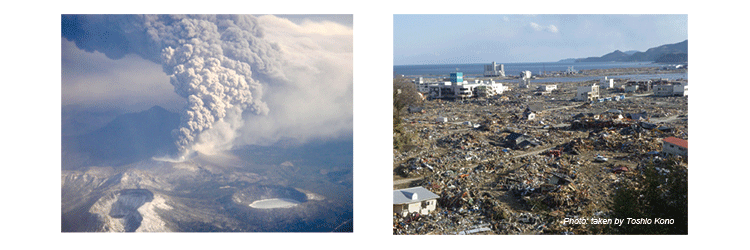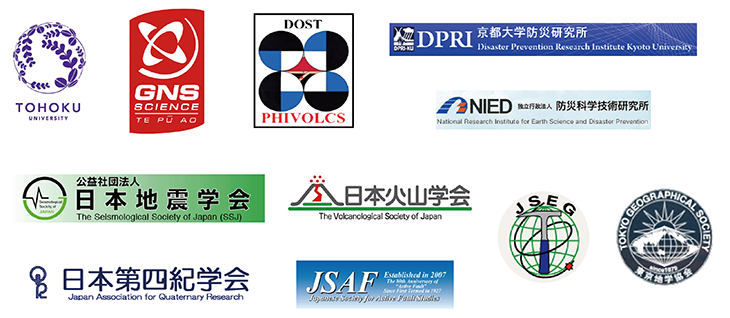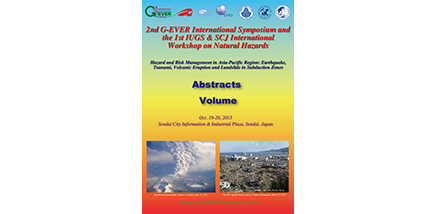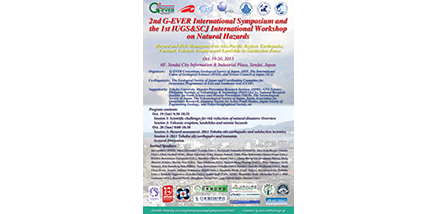




- 日付:
- 2013年10月19日(土) - 20日(日)
- 場所:
- 仙台市情報・産業プラザ 6F
- 後援:
- 東北大学
- 京都大学防災研究所
- 防災科学技術研究所
- ニュージーランド地質核科学研究所(GNS Science)
- フィリピン火山地震研究所(PHIVOLCS)
- 日本地震学会
- 日本火山学会
- 日本第四紀学会
- 日本活断層学会
- 応用地質学会
- 東京地学協会

- 開催の経緯:
- アジア太平洋地域は地震・津波・火山噴火の大規模自然災害のリスクが高い.一旦災害が発生すれば,高度に発達した国際経済社会では,被災国のみならず,国際的な問題に発展し得る.大規模自然災害への対策は人間の安全保障として,経済の持続的発展のためにも重要である.今,国際的な枠組みを作って協力し,我が国も含めたアジア太平洋諸国のリスク軽減のために情報収集メカニズムを構築することが望まれる.
- 開催の目的:
- 2011年3月11日の東北地方太平洋沖地震から2年半が経過し,世界各地で,地震・津波・火山噴火・地すべりを始めとする自然災害に対する防災,リスク対策が進められている.G-EVERコンソーシアムでは,海外及び国内の研究機関と協力して,下記の活動を推進している.
- アジア太平洋地域の地震及び火山防災関連の研究機関及び関連組織の協力体制の確立
- 各種地震及び火山関連の防災関連情報の提供と共有化の推進
- データベース構築・データ交換・災害リスクの低減のための国際標準化
- 第2回G-EVER国際シンポジウム,第1回IUGS・日本学術会議国際ワークショップでは,アジア太平洋地域の地震,津波,火山,地すべり等の自然災害に関する研究の現状と課題について広く議論を行うとともに,(1)災害に強い社会に変えていくために必要な今後の研究テーマや優先順位,(2)今後社会に必要とされるハザードマップのあり方およびアジア太平洋スケールでの取り組み,(3)固体地球科学からの貢献の重要性等について,今後10年間の将来展望を見すえた討論を行う.
- 日程:
- 10月19日(土)9:00- 9:30 レジストレーション
- 10月19日(土)9:30-18:10 講演会
- 10月20日(日)9:00-18:30 講演会&総合討論
- 10月19日9:30 - 20日18:30 ポスターセッション

- 第2回G-EVERシンポジウム, 第1回IUGS・日本学術会議ワークショップ講演要旨集 (PDF, 12.5MB) (2013年10月17日更新)

- 第2回G-EVERシンポジウム, 第1回IUGS・日本学術会議ワークショップポスター (PDF, 52.4MB)
- プログラム: (一部修正,10月17日)
- 10月19日(土)
- Opening addresses:
- Chair: Naoji Koizumi
- 9:30-9:45 Eikichi Tsukuda (Director General, GSJ, AIST, G-EVER Consortium President)
- 9:45-9:50 Roland Oberhaensli (IUGS President)
- 9:50-9:55 Ryo Matsumoto (SCJ-IUGS Japanese Branch)
- 9:55-10:00 Adichat Surinkum (Director, CCOP Technical Secretariat)
- Session 1: Scientific challenges for risk reduction of natural disasters: Overview
- Chair: Ryo Matsumoto, Yujiro Ogawa and Shinji Takarada
- 10:00-10:25 Catastrophic earthquakes and tsunami: Towards more effective risk reduction
- Ian Lambert (IUGS Secretary General) and Roland Oberhaensli (IUGS)
- 10:25-10:50 Response of the damaged scientists to the Tohoku earthquake-tsunami catastrophe
- Akira Ishiwatari (Tohoku Univ.)
- 10:50-11:15 Geosciences for post-2015 challenges of disaster risk reduction
- Kuniyoshi Takeuchi (ICHARM, PWRI)
- 11:15-11:35 [Coffee Break] (Group Photo)
- 11:35-12:00 Is satellite monitoring of remote volcanoes good enough for aviation safety?
- John Eichelberger (Alaska Univ., G-EVER Consortium Vice-President)
- 12:00-12:25 Scientific and social challenges of forecasting a VEI ≥7 eruption?
- Chris Newhall and Annie Winson (Earth Observatory of Singapore)
- 12:25 -12:50 Global earthquake and volcanic eruption risk management (G-EVER), next-generation volcanic hazard assessment system and Asia-Pacific region hazard mapping project
- Shinji Takarada, Joel Bandibas and G-EVER Promotion Team (Geological Survey of Japan, AIST)
- 12:50-14:30 [Lunch] & Poster Session Core Time
- SCJ-IUGS Japanese Branch Meeting
- Session 2: Volcanic eruption, landslides, seismic hazards, and hazard assessment
- Chair: James Goff, Yasuto Kuwahara and Akira Takada
- 14:30-14:55 Complexity of the Shinmoe-dake eruption in 2011
- Setsuya Nakada (ERI, Univ.of Tokyo)
- 14:55-15:20 From landslides to civil unrest: the implications of subduction zone earthquakes
- Peter Bobrowsky (Simon Fraser Univ.)
- 15:20-15:45 Submarine landslides and marine geohazards
- Kiichiro Kawamura (Yamaguchi University)
- 15:45-16:10 Landslides in tectonically active countries
- Masahiro Chigira and Toshitaka Kamai (Kyoto Univ.)
- 16:10-16:35 Landslide detection by broadband seismic network
- Cheng-Horng Lin (Academia Sinica)
- 16:35-16:55 [Coffee Break]
- 16:55-17:20 GEM-Faulted Earth: Towards a global active fault database
- Pilar Villamor (GEM-Faulted Earth team, GNS Science)
- 17:20-17:45 Proposals to revise ISC-GEM earthquake catalog
- Yuzo Ishikawa (Geological Survey of Japan, AIST)
- 17:45-18:10 Scenario-based tsunami hazard assessment for the coast of Vietnam from the Manila Trench source
- Nguyen Hong Phuong, Vu Ha Phuong and Pham The Truyen (VAST)
- 18:10-18:35 Toward a harmonized map of seismic hazard assessment (SHA) in the East Asia region
- Ken Xiansheng Hao and Hiroyuki Fujiwara (NIED)
- Oct. 20 (Sun)
- Session 3: Recent hazards, 2011 Tohoku-oki earthquake and subduction tectonics
- Chair: John Eichelberger, Ronald Harris and Kazuhisa Goto
- 9:25-9:50 Strong motion observation in April 20, 2013 Lushan, China, Earthquake and its damage implication
- Ruizhi Wen (China Earthquake Administration)
- 9:50-10:15 What occurred in the Japan trench region before and after the Tohoku-oki earthquake?: Seismological aspects
- Toru Matsuzawa (Tohoku Univ.)
- 10:15-10:40 Tsunami generation mechanism due to the 2011 Tohoku-oki earthquake and a new method for the real-time tsunami inundation prediction
- Yuichiro Tanioka and Aditya Gusman (Hokkaido Univ.)
- 10:40-11:00 [Coffee Break]
- 11:00-11:25 Subduction Zone Tectonics: Subduction accretion versus erosion and the implications for disastrous earthquakes
- Mark Cloos (Univ. Texas, Austin)
- 11:25-11:50 Crustal deformation of northeastern Japan clarified by geodetic observation over the past century
- Takuya Nishimura (Kyoto Univ.)
- 11:50-12:15 Strain buildup and release in the Northeast Japan orogen over geologic and geodetic time scales with implications for gigantic subduction earthquakes
- Yasutaka Ikeda(Univ. Tokyo)
- 12:15-13:30 [Lunch] & Poster Session Core Time
- Session 4: 2011 Tohoku-oki earthquake and tsunamis
- Chair: Pilar Villamor, Masahiro Chigira and Yuzo Ishikawa
- 13:30-13:55 The 2011 Tohoku-oki tsunami and paleotsunami deposits at the Pacific coast of Tohoku
- Kazuhisa Goto (Tohoku Univ.)
- 13:55-14:20 Sediment transport by the 2011 Tohoku-oki tsunami at Sendai Plain: implications from numerical simulation
- Daisuke Sugawara, Tomoyuki Takahashi and Fumihiko Imamura (Tohoku Univ.)
- 14:20-14:45 Tsunamis and tsunami deposits: Looking beyond the sand
- James Goff (Univ. NSW)
- 14:45-15:05 [Coffee Break]
- 15:05-15:30 Did earthquake science reduce causalities of the Mw 9.0 Tohoku-oki earthquake?
- Masataka Ando (Shizuoka University)
- 15:30-15:55 Implications of the 2011 Tohoku Earthquake for other subduction zones elsewhere
- Phil Cummins (ANU)
- 15:55-16:20 Who's next? History of tsunami disasters in Indonesia
- Ronald Harris, John Major and Yung-Chun Liu (Brigham Young University)
- 16:20-16:45 Geopolitics and earth's future: Natural disasters and related geoscientific research
- Yildirim Dilek (Miami University)
- 16:45-17:00 [Coffee Break]
- 17:00-18:25 General Discussion
- Chair: Chris Newhall, Yildirim Dilek, Yujiro Ogawa and Shinji Takarada
- 18:25-18:30 Hirokazu Kato (Emeritus Professor, Former Director General, GSJ, AIST)
- Closing Remarks
- Poster Session:
- P1. Quiescence in aftershock activity of the 2008 Iwate-Miyagi inland earthquake caused by the 2011 Tohoku-oki earthquake
- Yuhei Suzuki and Shinji Toda (Tohoku University)
- P2. Characteristic thickness distribution of the 2011 Tohoku-oki tsunami deposits in a narrow valley at the southern end of Sendai Plain
- Tomoya Abe (Nagoya University), Kazuhisa Goto (Tohoku University), Daisuke Sugawara (Tohoku University)
- P3. Tsunami deposits distribution in Sendai Plain evaluated by Sediment transport model
- Kohei Hashimoto (Tohoku University),Kazuhisa Goto (Tohoku University),Daisuke Sugawara (Tohoku University),Fumihiko Imamura (Tohoku University)
- P4. Geochemical characteristics of paleotsunami deposits
- Tetsuya Shinozaki, Shigehiro Fujino (University of Tsukuba) and Minoru Ikehara (Kochi University)
- P5. Distribution and age of the possible paleo-tsunami deposit at a coastal lowland, southeastern Kyushu
- Masaki Yamada, Shigehiro Fujino, Takashi Chiba (University of Tsukuba), Kazuhisa Goto (Tohoku Univ.) and James Goff (University of New South Wales)
- P6. Estimation of the sizes of paleotsunamis using tsunami boulders at Ishigaki Island, Japan
- Akifumi Hisamatsu, Kazuhisa Goto and Fumihiko Imamura (Tohoku University)
- P7. The combination of anisotropy of anhysteretic remanent magnetization (AARM) and grain size data provide information about the hydrodynamic conditions of the tsunami deposits
- Shusaku Kon, Norihiro Nakamura, Daisuke Sugawara, Kazuhisa Goto and Yasutaka Iijima (Tohoku University)
- P8. Deep structure of the seismic dangers regions in the Sea of Okhotsk
- Alexander Rodnikov (Russian Academy of Sciences)
- P9. Repeating earthquake activity along the Izu-Bonin trench
- Kota Hibino, Naoki Uchida (Tohoku University), Takeshi Matsushima (Kyushu University) and Toru Matsuzawa (Tohoku University)
- P10. Japan trench and Nankai trough: New scope of the two contrasting features of subduction zones and geo-hazardous aspect
- Yujiro Ogawa (Tsukuba University), Kiichiro Kawamura (Yamaguchi University), and Tomoyuki Sasaki (Ocean Engineering & Development Co. Ltd)
- P11. Sanriku-oki large slump deposits and feasibility studies for future scientific drilling accounting for submarine landslide mechanism
- Sumito Morita (GSJ, AIST), Shusaku Goto (GSJ, AIST), Yuichiro Miyata (Yamaguchi University), Yuki Nakamura (University of Tokyo), Yu Kitahara (Kochi University) and Yasuhiro Yamada (Kyoto University)
- P12. Structural characteristics of large-scale submarine landslides on a very gentle continental slope from 3D seismic data off Shimokita Peninsula, Northeast Japan
- Yuki Nakamura (University of Tokyo), Sumito Morita (GSJ, AIST), Juichiro Ashi (University of Tokyo)
- P13. The estimation of the low-velocity subducting crust of the Pacific slab beneath Hokkaido, northern Japan
- Takahiro Shiina, Junichi Nakajima, Genti Toyokuni, and Toru Matsuzawa (Tohoku University)
- P14. A study of earthquake location by artificial explosive data
- Chien-Hsin Chang, Peih-Lin Leu and Tzay-Chyn Shin (Department of Seismological Center, Central Weather Bureau, Taiwan)
- P15. Cooperative hydrological and geochemical research for earthquake forecasting in Taiwan between Disas.Prev.Res.Center, NCKU, Taiwan and Geological Survey of Japan, AIST
- Naoji Koizumi, Norio Matsumoto (GSJ, AIST), Wen-Chi Lai (National Cheng Kung University) and Mamoru Nakamura (University of the Ryukyu)
- P16. Experimental analysis on Rowe’s stress-dilatancy relation and frictional instability of fault gouges
- Momoko Hirata, Jun Muto, Hiroyuki Nagahama and Kenshiro Otsuki (Tohoku University)
- P17. Self-affinities Analysis of Fault-related Folding
- Kazuhei Kikuchi (Tohoku University), Kazutoshi Abiko (Yamagata Prefectural Government), Hiroyuki Nagahama and Jun Muto (Tohoku University)
- P18. Application of GIS Technology in heavy metal source analysis of river water in mining area
- Qingqing Lu, Noriyoshi Tsuchiya, Takahiro Watanabe, Ryo Yamada and Shinichi Yamasaki (Tohoku University)
- P19. Inhomogeneity of fractal property in rock minerals using 3D X-ray CT measurement
- Junko Yamaki, Jun Mutoa, Hiroyuki Nagahama, Osamu Sasaki, and Harumasa Kano (Tohoku University)
- P20. Seismic luminous phenomena and VHF electromagnetic emission originated from radon emanation
- Asuka Seki (Tohoku University), Izumi Tohbo (Mitsubishi Research Institute), Yasutaka Omori (National Institute of Radiological Science), Jun Muto and Hiroyuki Nagahama (Tohoku University)
- P21. Electromagnetic radiations from semiconductor minerals
- Mitsuyuki Ozawa, Jun Muto, Hiroyuki Nagahama, Toshiro Nagase (Tohoku University)
- P22. Sinusoidal model for the annual variation of atmospheric radon concentration in Japan
- Saki Nakamura, Koseki Hayashi, Yumi Yasuoka (Kobe Pharmaceutical University), Hiroyuki Nagahama, Jun Muto (Tohoku University), Yasutaka Omori (National Institute of Radiological Sciences), Tetsuo Ishikawa, Toshiyuki Suzuki, Yoshimi Homma (Fukushima Medical University), Hayato Ihara (Wakayama Medical University), Takahiro Mukai (Kobe Pharmaceutical University)
- P23. Hazard mitigation of a caldera-forming eruption: From past experience in Indonesia to modern society
- Akira Takada, Ryuta Furukawa (GSJ, AIST), Kiyoshi Toshida (CRIEPI), Supriyati Andreastuti and Nugraha Kartadinata (CVGHM)
- P24. Rainfall induced disasters in India with special reference to Uttarakhand calamity
- Ravi Kumar Umrao, Rajesh Singh and Trilok Nath Singh (Indian Institute of Technology)
- P25. Web Based Rapid Mapping of Disaster Areas using Satellite Images, Web Processing Service, Web Mapping Service, Frequency Based Change Detection Algorithm and J-iView
- Joel Bandibas and Shinji Takarada (Geological Survey of Japan, AIST)
- P26. Geoethical elements in risk communication
- Jose Luis González Garcia (Complejo de la Moncloa), Jesús Martínez-Frías (Geosciences Institute, CSIC-UCM) and Niichi Nishiwaki (Nara University)
- (下線: 発表者)
- 地質巡検:
- 10月21日(月) 地質巡検 津波堆積物,津波被災地域(日帰り)
- [先着40名,招待講演者優先]
- 巡検内容は,2013年地質学会仙台大会と同じ予定です.
- 当日参加:(定員100名に達するまで)
- 受付 10月19日(土)9時より 仙台市情報・産業プラザ アエル6階
- 入場料:
- 無料
- 口頭発表及びポスター発表について:
- 口頭発表: ご発表用のPPTファイルをUSBメモリでご持参下さい.事前に,MS-Power Point 2007もしくは2012 (Windows版)での動作確認をお願いします.事務局では,講演者用の演台に,Windows用ノートパソコンを1台準備しますので,各自の発表のセッションが始まる前に,ご自身のPPTファイルをアップロードし,動作確認を行って頂ければ幸いです.動画等の関係でご自身のノートパソコンをご利用になられたい場合は,事前にご相談頂ければ幸いです.
- ポスター発表: 縦180cm x 横120cmのポスター用ボードを用意します.このサイズに納まるようにポスターをご準備下さい.ピンなどは事務局で準備します.10月19日9時30分までにポスターを掲示して頂き,10月20日18時45分までには撤去をお願いします.コアタイムは,19日12:45-14:30と20日12:15-13:30の2回です(昼食時間は各自ご調整下さい).コーヒー等のドリンクサービスがポスター会場で行われます.
